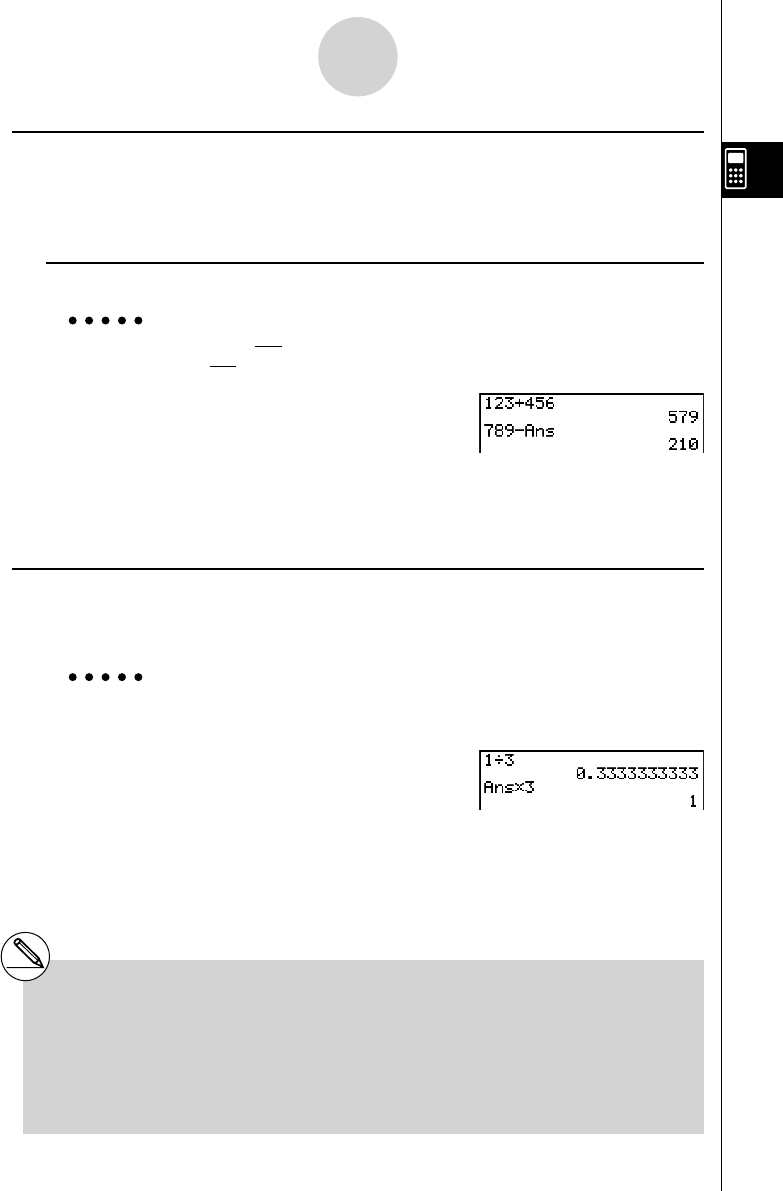User's Manual
Table Of Contents
- Quick-Start
- Precautions when Using this Product
- Contents
- Getting Acquainted— Read This First!
- Chapter 1 Basic Operation
- Chapter 2 Manual Calculations
- Chapter 3 List Function
- Chapter 4 Equation Calculations
- Chapter 5 Graphing
- 5-1 Sample Graphs
- 5-2 Controlling What Appears on a Graph Screen
- 5-3 Drawing a Graph
- 5-4 Storing a Graph in Picture Memory
- 5-5 Drawing Two Graphs on the Same Screen
- 5-6 Manual Graphing
- 5-7 Using Tables
- 5-8 Dynamic Graphing
- 5-9 Graphing a Recursion Formula
- 5-10 Changing the Appearance of a Graph
- 5-11 Function Analysis
- Chapter 6 Statistical Graphs and Calculations
- Chapter 7 Financial Calculation (TVM)
- Chapter 8 Programming
- Chapter 9 Spreadsheet
- Chapter 10 eActivity
- Chapter 11 System Settings Menu
- Chapter 12 Data Communications
- Appendix

20070201
k Answer Function
The Answer Function automatically stores the last result you calculated by pressing
w (unless the w key operation results in an error). The result is stored in the answer
memory.
u To use the contents of the answer memory in a calculation
Example 123 + 456 = 579
789 – 579 = 210
A bcd+efg w
hij- !- (Ans)w
In the Math input mode, the answer memory is refreshed with each calculation. Note,
however, that the answer memory content recall operation is different from that used in
the Linear input mode. For details, see “History Function” (page 2-2-6).
k Performing Continuous Calculations
Answer memory also lets you use the result of one calculation as one of the arguments in
the next calculation.
Example 1 ÷ 3 =
1 ÷ 3 × 3 =
A b/d w
(Continuing)*d w
Continuous calculations can also be used with Type B functions (
x
2
, x
–1
, x! , page 2-1-4),
+, –, ^( x
y
),
x
' , ° ’ ”, etc.
2-2-5
Special Functions
# The largest value that the answer memory
can hold is 15 digits for the mantissa and 2
digits for the exponent.
# Only numeric values and calculation results
can be stored in answer memory.
# Answer memory contents are not cleared when
you press the A key or when you switch power
off.
# When “Linear” is selected as the Input Mode,
answer memory contents are not changed by an
operation that assigns values to Alpha memory
(such as: f a av (A)w ).










